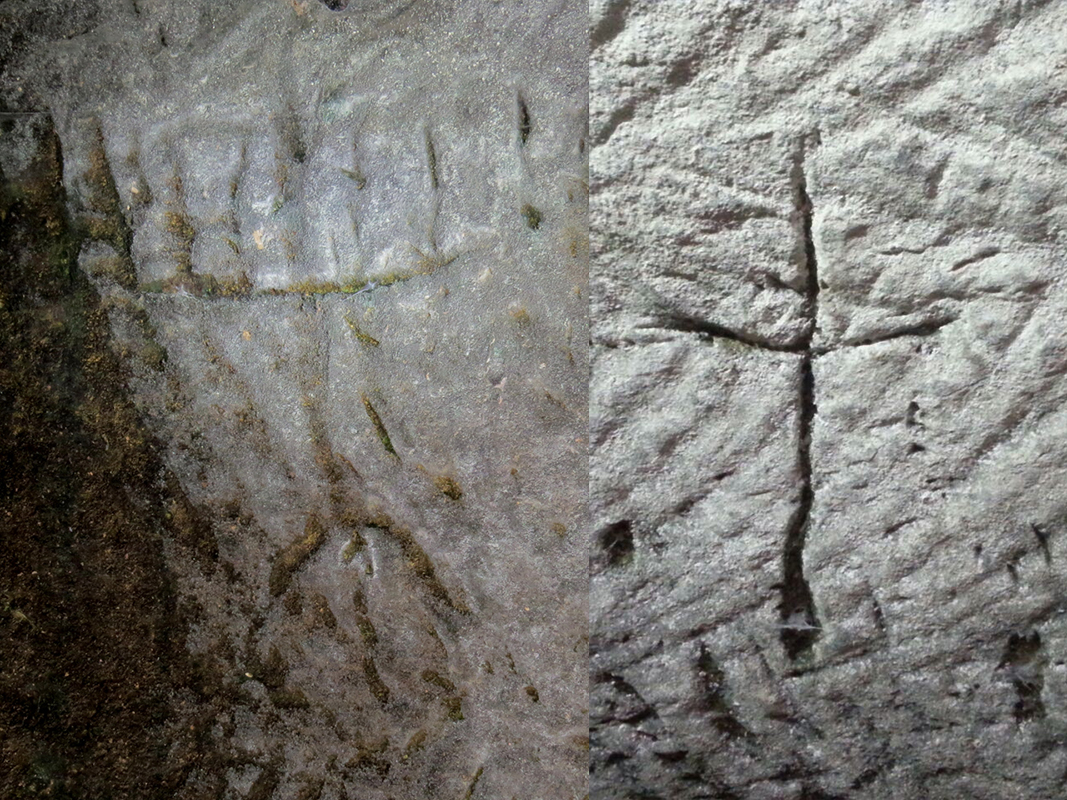Ancient Cross and Menorah Carvings Found Side by Side

Engravings of a cross and a menorah carved thousands of years ago were recently found in a cave in Israel, according to the Israel Antiquities Authority (IAA). Though the two figures were etched close together on a cistern wall, they were likely created hundreds of years apart, the archaeologists said.
Hikers unexpectedly came upon the ancient carvings while exploring subterranean passages in southern Israel. Archaeologists with the IAA dated the menorah carving to the second century A.D. and the cross to the fourth century A.D. The menorah, which has seven arms and three legs, represents the traditional candelabra that stood in the Second Temple in Jerusalem, IAA experts said in a statement. [The Holy Land: 7 Amazing Archaeological Finds]
The discovery of two side-by-side symbols associated with Judaism and Christianity, respectively, coincides with a rare overlap of the Hanukkah and Christmas holidays in 2016, with the first night of Hanukkah falling on Christmas Eve. Such an alignment has happened only four times since 1900 — in 1902, 1940, 1978 and 2016, Vox.com reported.
Other carvings on the walls, including one that resembles a key, are yet to be identified. But some of the underground caves at this lowlands site, known as the Judean Shephelah, have long been recognized as hideouts for renegade Jews during the uprising led by Simon bar Kokhba against the Roman invaders around 2,000 years ago, said Sa'ar Ganor, the district archaeologist of Ashkelon for the IAA.

"The menorah was probably etched in the cistern after the water installation was hewn in the bedrock, maybe by inhabitants of the Jewish settlement that was situated there during the Second Temple period and the time of Bar Kokhba," Ganor said in the statement.
"The cross was etched later on, during the Byzantine period," he added.
Modern menorahs typically have nine arms, eight representing the eight nights of Hanukkah, and one extra to hold the candle that lights all the others. The seven-armed design is associated with menorahs used in the First and Second Temples, and predates the Hanukkah holiday, which emerged after the destruction of the Second Temple by the Romans in A.D. 70.
Sign up for the Live Science daily newsletter now
Get the world’s most fascinating discoveries delivered straight to your inbox.
The seven-armed menorah was an important symbol for Jews in the ancient world; it may even have been used to identify kosher bread about 1,500 years ago, IAA archaeologists announced in 2012. Excavations in Akko, a city in Israel, uncovered a ceramic stamp carved in the shape of a seven-branched menorah, which was likely used by a baker during the Byzantine period to mark baked goods for Jewish customers.
Menorah symbols have also been found in ancient Hebrew scrolls, stamped on a jar handle and in graffiti carved into stone in an ancient Turkish city.
But wall engravings of menorahs are less common, making this new find important for unraveling the puzzle of life in the Judean Shephelah caves thousands of years ago, Ganor explained.
"It is rare to find a wall engraving of a menorah," Ganor said. "This exciting discovery, which was symbolically revealed during the Hanukkah holiday, substantiates the scientific research regarding the Jewish nature of the settlement during the Second Temple period."
Original article on Live Science.

Mindy Weisberger is an editor at Scholastic and a former Live Science channel editor and senior writer. She has reported on general science, covering climate change, paleontology, biology and space. Mindy studied film at Columbia University; prior to Live Science she produced, wrote and directed media for the American Museum of Natural History in New York City. Her videos about dinosaurs, astrophysics, biodiversity and evolution appear in museums and science centers worldwide, earning awards such as the CINE Golden Eagle and the Communicator Award of Excellence. Her writing has also appeared in Scientific American, The Washington Post and How It Works Magazine. Her book "Rise of the Zombie Bugs: The Surprising Science of Parasitic Mind Control" will be published in spring 2025 by Johns Hopkins University Press.










